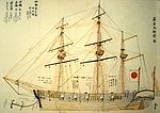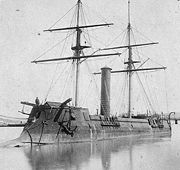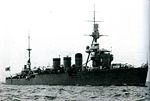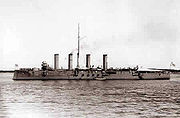
List of ships of the Japanese Navy
Encyclopedia
The following is the list of ships of the Imperial Japanese Navy
, including ships that are no longer in service. For a list of ships of its successor, the Japan Maritime Self-Defense Force
, see JMSDF Fleet.

 (1854) – Japan's first post-seclusion Western-style sail warship. (1854) (1856)
(1854) – Japan's first post-seclusion Western-style sail warship. (1854) (1856)
 , (1864–1888) – Japan's first ironclad warship, later renamed Azuma {Ex-"CSS Stonewall"} (1877–1910)
, (1864–1888) – Japan's first ironclad warship, later renamed Azuma {Ex-"CSS Stonewall"} (1877–1910)
– Battlecruisers rebuilt as fast battleships
 (1942) (1943)
(1942) (1943)
 (1884–1912)
(1884–1912)
(1886–1887)
(1890–1911)
(1891–1927)
(1892–1892)

(1894–1927)
(1893–1904)
 (1898–1904)
(1898–1904)
(1904–1917)

(1910–1931)



(1923–1944)



(1900–1946)
 (1900–1944)
(1900–1944)


(battlecruisers converted to "fast battleships" in 1920s)



)
List of IJN Patrol Vessels can be found here at http://homepage2.nifty.com/nishidah/e/s_xa0f.htm

2nd Class Submarines

3rd Class Submarines
 , 50 units., about 250 units (750 planned)., about 1000 units.
, 50 units., about 250 units (750 planned)., about 1000 units.
Army submarines
Other submarines
Imperial Japanese Navy
The Imperial Japanese Navy was the navy of the Empire of Japan from 1869 until 1947, when it was dissolved following Japan's constitutional renunciation of the use of force as a means of settling international disputes...
, including ships that are no longer in service. For a list of ships of its successor, the Japan Maritime Self-Defense Force
Japan Maritime Self-Defense Force
The , or JMSDF, is the naval branch of the Japan Self-Defense Forces, tasked with the naval defense of Japan. It was formed following the dissolution of the Imperial Japanese Navy after World War II....
, see JMSDF Fleet.
Medieval warships
- AtakebuneAtakebunewere large Japanese warships of the 16th and 17th century internecine Japanese wars for political control and unity of all Japan.Japan undertook major naval building efforts in the mid to late 16th century, during the Sengoku period, when feudal rulers vying for supremacy built vast coastal navies...
, 16th century coastal battleships. - Red seal shipsRed seal shipswere Japanese armed merchant sailing ships bound for Southeast Asian ports with a red-sealed patent issued by the early Tokugawa shogunate in the first half of the 17th century...
– Around 350 armed sailships, commissioned by the Bakufu in the early 17th century, for Asian and South-East Asian trade. (1607) – Built by William AdamsWilliam Adams (sailor)William Adams , also known in Japanese as Anjin-sama and Miura Anjin , was an English navigator who travelled to Japan and is believed to be the first Englishman ever to reach that country...
for Tokugawa IeyasuTokugawa Ieyasuwas the founder and first shogun of the Tokugawa shogunate of Japan , which ruled from the Battle of Sekigahara in 1600 until the Meiji Restoration in 1868. Ieyasu seized power in 1600, received appointment as shogun in 1603, abdicated from office in 1605, but...
. Crossed the Pacific in 1610. (1614) – One of Japan's first Western-style sail warships, transported the embassy of Hasekura TsunenagaHasekura TsunenagaHasekura Rokuemon Tsunenaga or was a Japanese samurai and retainer of Date Masamune, the daimyo of Sendai....
to America in 1614.
Western-style sail warships


Steam warships
- Kankō MaruKanko MaruThe was Japan's first steam warship. The ship was a 3-masted top sail schooner , with an auxiliary coal-fired steam engine turning a side paddlewheel...
(1855), Japan's first steam warship. (1855) – Japan's first screw-driven steam warship (1858) (1866) (1863), Japan's first domestically-built steam warship. (1864)
Corvettes and gunboats
-
- (1877)
- (1877)
- (1882, ex-Chinese, captured 1895) – Armored gunboat
Battleships

- Battleship prizes of the First Sino-Japanese WarFirst Sino-Japanese WarThe First Sino-Japanese War was fought between Qing Dynasty China and Meiji Japan, primarily over control of Korea...
:- (1882, ex-Chinese Chen Yuen (1895–1914))
-
- (1896–1948)
- (1896–1904)
-
- (1898–1948)
- (1899–1904) (1899–1942) (1900 – Preserved)
- Battleship prizes of the Russo-Japanese WarRusso-Japanese WarThe Russo-Japanese War was "the first great war of the 20th century." It grew out of rival imperial ambitions of the Russian Empire and Japanese Empire over Manchuria and Korea...
:- (1889, ex-Russian Imperator Nikolai IRussian battleship Imperator Nikolai IImperator Nikolai I was a Russian pre-dreadnought battleship built for the Baltic Fleet in the late 1880s. She participated in the celebration of the 400th anniversary of the discovery of America in New York City in 1892. She assigned to the Mediterranean Squadron and visited Toulon in October 1893...
) (1905–1915) - (1892, ex-Russian PoltavaRussian battleship PoltavaTwo battleships of the Imperial Russian Navy have been named Poltava, after the Battle of Poltava:*Poltava was a Petropavlovsk class battleship launched in 1894. She was captured by the Japanese in 1905 and became the Japanese battleship Tango. She was returned to Russia in 1916 and renamed Chesma...
) (1905–1923) - (1898, ex-Russian Peresviet) (1905–1916)
- (1900, ex-Russian Pobieda) (1905–1946)
- (1900, ex-Russian RetvizanRussian battleship RetvizanRetvizan was a Russian pre-dreadnought battleship built before the Russo-Japanese War of 1904–05 for the Imperial Russian Navy in the United States. She was built by the William Cramp and Sons Ship & Engine Building Company of Philadelphia, although the armament was made at the Obukhov works in...
) (1905–1924) - (1902, ex-Russian Orel) (1905–1924)
- (1894, ex-Russian Admiral Senyavin) (1905–1936)
- (1896, ex-Russian General-Admiral Graf Apraxin) (1905–1925)
- (1889, ex-Russian Imperator Nikolai I
-
- (1905–1924)
- (1905–1924)
-
- (1906–1924)
- (1907–1923)
-
- (1910–1918)
- (1911–1924)
– Battlecruisers rebuilt as fast battleships
-
- (1912–1944)
- (1912–1942)
- (1913–1945)
- (1913–1942)
-
- (1914–1944)
- (1915–1944)
-
- (1916–1945)
- (1917–1945)
-
- (1919–1946)
- (1920–1943)
- Battleship prizes of World War IWorld War IWorld War I , which was predominantly called the World War or the Great War from its occurrence until 1939, and the First World War or World War I thereafter, was a major war centred in Europe that began on 28 July 1914 and lasted until 11 November 1918...
:- ex-TurkishTurkeyTurkey , known officially as the Republic of Turkey , is a Eurasian country located in Western Asia and in East Thrace in Southeastern Europe...
Torgud Reis, ex-German Weissenburg, assigned but not taken over) – BU 1938 - ex-German NassauSMS NassauSMS Nassau"SMS" stands for "Seiner Majestät Schiff", or "His Majesty's Ship" in German. was the first dreadnought battleship built for the Imperial German Navy, a response to the launching of the British battleship HMS Dreadnought in 1906...
BU 1920 - ex-German OldenburgSMS OldenburgThere were two ships in the German Imperial Navy with the name SMS Oldenburg, both named after the Grand Duchy of Oldenburg:*SMS Oldenburg *SMS Oldenburg...
– BU 1921
- ex-Turkish
- Kaga-class
- (1921 – converted to an aircraft carrier)
- Tosa (cancelled 1922)
-
- (1940–1945)
- (1940–1944)
- (converted to an aircraft carrier)
- No.111 (cancelled 1942)
- No.797 (not started)
Aircraft carriers
(1913) (1920) (1921) (1921) (1925) (1931) (1934)-
- (1935)
- (1937)
- (1935)
- (1936) (1938)
- (1939)
- (1939)
- (1941)
- (1941)
- (1939)
- (1939)
- (1940)
- (1941)
- (1942)

-
- (1943)
- (1944)
- (1943)
- (1943)
- (1944)
- (not completed)
- Aso (not completed)
- Ikoma (not completed) (1944)
- (1944)
- Otakisan Maru (not completed)
- (1944)
- Chigusa Maru (not completed) (1945)
Protected Cruisers
- ex-Chinese cruisers as prizes of First Sino-Japanese WarFirst Sino-Japanese WarThe First Sino-Japanese War was fought between Qing Dynasty China and Meiji Japan, primarily over control of Korea...
- (1895–1904)

-
- (1885–1912)
- (1885–1914)
(1886–1887)
(1890–1911)
(1891–1927)
(1892–1892)

-
- (1891–1926)
- (1892–1908)
- (1894–1927)
(1894–1927)
(1893–1904)
-
- (1896–1923)
- (1899–1928)

-
- (1898–1916)
- (1898–1928)
-
- (1904–1923)
- (1904–1936)
(1904–1917)

-
- (1912–1931)
- (1912–1940)
- (1912–1940)
(1910–1931)
- ex-Russian cruisers as prizes of Russo-Japanese WarRusso-Japanese WarThe Russo-Japanese War was "the first great war of the 20th century." It grew out of rival imperial ambitions of the Russian Empire and Japanese Empire over Manchuria and Korea...
- (1901, ex-Russian PalladaRussian cruiser Pallada (1899)The RUS Pallada was the lead ship in the of protected cruisers in the Imperial Russian Navy. It was built in Admiralty Shipyard, Saint Petersburg, Russia...
, 1908–1921) - (1901, ex-Russian Varyag, 1907–1916)
- (1901, ex-Russian NovikRussian cruiser Novik (1900)Novík was a protected cruiser in the Imperial Russian Navy, built by Schichau shipyards in Elbing near Danzig, Germany.-Background:Novik was a very fast ship for the time, but smaller than most contemporary cruisers, and perhaps a forerunner of later light cruisers...
, 1906–1913)
- (1901, ex-Russian Pallada
Dispatch Vessels

-
- (1908–1940)
- (1908–1928)
Light Cruisers
-
- (1919–1942)
- (1919–1944)

-
- (1920–1944)
- (1921–1944)
- (1921–1945)
- (1921–1944)
- (1921–1944)
- ex-German cruisers as prize of World War IWorld War IWorld War I , which was predominantly called the World War or the Great War from its occurrence until 1939, and the First World War or World War I thereafter, was a major war centred in Europe that began on 28 July 1914 and lasted until 11 November 1918...
- Y (1909, ex-German Augsburg, 1920–1922)

-
- (1922–1944)
- (1923–1945)
- (1923–1942)
- (1922–1944)
- (1922–1944)
- (1925–1944)
-
- (1924–1943)
- (1925–1943)
- (1925–1944)
(1923–1944)

- ex-Republic of ChinaRepublic of ChinaThe Republic of China , commonly known as Taiwan , is a unitary sovereign state located in East Asia. Originally based in mainland China, the Republic of China currently governs the island of Taiwan , which forms over 99% of its current territory, as well as Penghu, Kinmen, Matsu and other minor...
cruisers as prizes of Second Sino-Japanese WarSecond Sino-Japanese WarThe Second Sino-Japanese War was a military conflict fought primarily between the Republic of China and the Empire of Japan. From 1937 to 1941, China fought Japan with some economic help from Germany , the Soviet Union and the United States...
- (1931 ex-Ning Hai) (1937–1944)
- (1935 ex-P'ing Hai) (1937–1944)
-
- (1940–1944)
- (1940–1945)
- (1941–1945)
- Kashiwara (not completed)

-
- (1942–1944)
- (1943–1945)
- (1943–1944)
- (1944–1945)
-
- (1943–1945)
- Niyodo (not completed)
Armored cruisers

-
- (1899–1945)
- (1899–1945)
-
- (1900–1945)
- (1901–1945)
(1900–1946)

-
- (1904–1945)
- (1904–1936)

- ex-Russian armored cruiserArmored cruiserThe armored cruiser was a type of warship of the late 19th and early 20th centuries. Like other types of cruiser, the armored cruiser was a long-range, independent warship, capable of defeating any ship apart from a battleship, and fast enough to outrun any battleships it encountered.The first...
s as prizes of the Russo-Japanese WarRusso-Japanese WarThe Russo-Japanese War was "the first great war of the 20th century." It grew out of rival imperial ambitions of the Russian Empire and Japanese Empire over Manchuria and Korea...
- (1903, ex-Russian BayanRussian cruiser BayanThe cruiser Bayan was the lead ship in the of armored cruisers in the Imperial Russian Navy. It was built in Toulon, France by the Compagnie des Forges et Chantiers de la Méditerranée à la Seine...
, 1908–1931)
- (1903, ex-Russian Bayan
Battlecruisers
-
- (1907–1917)
- (1908–1923)

-
- (1909–1923)
- (1911–1923)
(battlecruisers converted to "fast battleships" in 1920s)
-
- (1913–1945)
- (1914–1942)
- (1915–1945)
- (1915–1942)
- Amagi-class battlecruisers:
- Amagi (not completed)
- (converted to aircraft carrier)
- Atago (not launched)
- Takao (not launched)
Heavy Cruisers
-
- (1926–1942)
- (1926–1942)
-
- (1927–1945)
- (1927–1942)

-
- (1929–1946)
- (1928–1944)
- (1928–1945)
- (1929–1945)
- (1932–1945)
- (1932–1944)
- (1932–1944)
- (1932–1944)

-
- (1935–1944)
- (1935–1942)
- (1937–1944)
- (1937–1944)
-
- (1938–1945)
- (1939–1944)

- Ibuki class
- (1943; converted to aircraft carrier)
- ? (No. 301) (not launched)
1st Class Destroyers
(1919–1922)-
- Kamikaze-class (1922–1925)
- (1925–1927)
- (1927–1931)
- (1931–1932)
- (1932–1934)
- (1935–1937)
- (1936–1937)
- (1938–1941)
- (1941–1944)
- Akizuki-classAkizuki class destroyer (1942)The was one of the primary classes of new destroyers of the Imperial Japanese Navy after 1942. The IJN called them from their plan name. They were designed to fight larger ships, aircraft and submarines....
(1941–1944)- Mochizuki (not completed)
- (1942)
- (1944–1948)
- (1944–1945)
- Azusa (not launched)
- Hishi (not launched)
- Katsura (not completed)
- Kuzu (not launched)
- NashiJDS Wakaba (DE-261)JDS Wakaba was the former IJN Nashi, a Tachibana-class destroyer. The Nashi was sunk in July 1945, but salvaged in 1954 as the Wakaba, later being refitted as a radar trials ship...
– later the JDS Wakaba (DE-261) - Sakaki (not launched)
- Tochi (not completed)
- Wakazakura (not launched)
- Yadake (not completed)
- Yaezakura (not completed)
2nd Class Destroyers
(1919–1922)-
- (1922–1923)
Torpedo Boats
(1933)-
- (1935–1937)
River Gunboats
{formerly ) {formerly {USS Wake (PR-3)USS Wake (PR-3)
USS Wake was a United States Navy river gunboat operating on the Yangtze River, that was seized by Japan on 8 December 1941.Originally commissioned as the gunboat Guam , she was redesignated river patrol vessel PR-3 in 1928, and renamed Wake in 1941.-Service history:She was launched on 28 May...
)
- 25 ton class riverine gunboat
Patrol Vessels
- Type I submarine chaser (驅潛特務艇第一號型): Over 200 built during the World War IIWorld War IIWorld War II, or the Second World War , was a global conflict lasting from 1939 to 1945, involving most of the world's nations—including all of the great powers—eventually forming two opposing military alliances: the Allies and the Axis...
, 81 lost.
List of IJN Patrol Vessels can be found here at http://homepage2.nifty.com/nishidah/e/s_xa0f.htm
- Patrol Boat # 01-see http://www.combinedfleet.com/PB-1_t.htm
- Patrol Boat # 02-see http://www.combinedfleet.com/PB-2_t.htm
- Patrol Boat # 31-see http://www.combinedfleet.com/PB-31_t.htm
- Patrol Boat # 32-sunk at Battle of Wake IslandBattle of Wake IslandThe Battle of Wake Island began simultaneously with the Attack on Pearl Harbor and ended on 23 December 1941, with the surrender of the American forces to the Empire of Japan...
- Patrol Boat # 33-sunk at Battle of Wake IslandBattle of Wake IslandThe Battle of Wake Island began simultaneously with the Attack on Pearl Harbor and ended on 23 December 1941, with the surrender of the American forces to the Empire of Japan...
- Patrol Boat # 34-see http://www.combinedfleet.com//PB-34_t.htm
- Patrol Boat # 35-see http://www.combinedfleet.com//PB-35_t.htm
- Patrol Boat # 36-see http://www.combinedfleet.com//PB-36_t.htm
- Patrol Boat # 37-see http://www.combinedfleet.com/Shokaitei.htm
- Patrol Boat # 38-see http://www.combinedfleet.com/Shokaitei.htm
- Patrol Boat # 39-see http://www.combinedfleet.com/Shokaitei.htm
- Patrol Boat # 46-see http://www.combinedfleet.com/PB-46_t.htm
- Patrol Boat # 101-see http://www.combinedfleet.com/PB-101_t.htm
- Patrol Boat # 102-formerly USN Destroyer USS Stewart (DD-224)USS Stewart (DD-224)USS Stewart was a Clemson-class destroyer in the United States Navy during World War II. She was the second ship named for Rear Admiral Charles Stewart. Scuttled in a port, she was later raised by the Japanese and commissioned as Patrol Boat No. 102...
- Patrol Boat # 103-formerly USN minesweeperUSS Finch (AM-9)USS Finch (AM-9)USS Finch was a acquired by the U.S. Navy for the dangerous task of removing mines from minefields laid in the water to prevent ships from passing. Finch was named for the finch, and is strictly speaking the only U.S. vessel named for such....
- Patrol Boat # 104-see http://www.combinedfleet.com//PB-104_t.htm
- Patrol Boat # 105-see http://www.combinedfleet.com/PB-105_t.htm
- Patrol Boat # 106-see http://www.combinedfleet.com//PB-106_t.htm
- Patrol Boat # 107-see USS Genesee (AT-55)USS Genesee (AT-55)USS Genesee , formerly Monocacy, was a fleet tug in the U.S. Navy in World War I and World War II built in 1905. She was scuttled on 5 May 1942 at Corregidor to avoid capture. Nevertheless, she was raised by the Japanese and designated as Patrol Boat No. 107...
- Patrol Boat # 108-see http://www.combinedfleet.com//PB-108_t.htm
- Patrol Boat # 109-see http://www.combinedfleet.com//PB-109_t.htm
- Sparviero class
Submarines
1st Class Submarines- Junsen-class
- J1 typeJ1 type submarineThe Type J1 submarines were large cruiser submarines of the Imperial Japanese Navy.Four boats were built between 1926 and 1929.These boats, based on the KD2 and U-139 designs, were of a junsen, or cruiser, type with an impressive range of 24,000 nm...
,, 4 units, , I-2, I-3, I-4. - J1M type,, I-5.
- J2 type,, I-6.
- J3 type,, 2 units, I-7, .
- J1 type
- Kou-class
- A1 typeA1 type submarineA1 Type submarines were submarines of the Imperial Japanese Navy during World War II, equipped with an aircraft. The design was an adaptation of the J3 Type design, with the hangar opening forward of the conning tower....
, , 3 units, I-9, I-10, I-11. - A2 typeA2 type submarineThe Type A2 submarine was a single class of submarine in the Imperial Japanese Navy during World War II, consisting of one boat, I-12, equipped with an aircraft. The design was similar to the earlier Type A1 submarine, except for the A2's having weaker engines...
, , .
- A1 type
-
- AM typeType AM Japanese submarineThe AM type submarine was a large seaplane-carrying submarine of the Imperial Japanese Navy, with a hangar space for 2 aircraft. These giant submarines were originally of the A2 type, meant to act as command boats for groups of submarines, but their design was revised after construction started so...
, , 2 units, I-13, I-14.
- AM type
- Otu-class
- B1 typeB1 type submarineThe Type B1 submarine were the most numerous submarine class of the Imperial Japanese Navy during World War II...
,, 20 units, I-15, , , I-21, I-23, , , I-27, I-28, , I-30, I-31, I-32, I-33, , I-35, I-36, I-37, I-38, I-39. - B2 type,, 6 units, I-40, I-41, I-42, I-43, I-44, I-45.
- B3 type,, 3 units, I-54, I-56, .
- B1 type
- Hei-class
- C1 type,, 5 units, I-16, I-18, I-20, I-22, I-24.
- C2 type,, 3 units, I-46, I-47, I-48.

-
- C3 typeC3 type submarineType C3 submarines were operated by the Imperial Japanese Navy, designed and built by Mitsubishi Corporation, between 1943 and 1944, as cargo carriers....
,, 3 units, , I-53, .
- C3 type
- Tei-class
- D1 type,, 12 units, I-361, I-362, I-363, I-364, I-365, I-366, I-367, I-368, I-369, I-370, I-371, I-372(S51B).
- D2 type,, I-373.
- Kaidai-class
- KD1 type,, I-51.
- KD2 type,, I-152(52).
- KD3a type,, 4 units, I-153(53), I-154(54), I-155(55), I-158(58).
- KD3b type,, 5 units, I-156(56), I-157(57), I-159(59), I-60, I-63.
- KD4 type,, 3 units, I-61, I-162(62), I-164(64),
- KD5 type,, 3 units, I-165(65), I-166(66), I-67,
- KD6a type,, 6 units, (68), I-169(69), I-70, I-171(71), I-172(72), I-73.
- KD6b type,, 2 units, I-174(74), I-175(75).
- KD7 type,, 10units, (76), I-177, I-178, I-179, I-180, I-181, I-182, I-183, I-184, I-185.
- Toku typeI-400 class submarineThe Imperial Japanese Navy submarines were the largest submarines of World War II and remained the largest ever built until the construction of nuclear ballistic missile submarines in the 1960s. They were submarine aircraft carriers able to carry three Aichi M6A Seiran aircraft underwater to their...
,, 3 units, I-400, , I-402 (I-404 not launched, I-405 not completed). - Senkou dai typeI-200 class submarineThe were submarines of the Imperial Japanese Navy during World War II. These submarines were of advanced design, built for high underwater speed, and were known as or...
,, 3 units, I-201, I-202, I-203 (I-204 to I-208 not completed). - Senho type,, I-351 (I-352 not completed).
- Kiraisen (Mine layer) typeI-121 class submarineThe was a class of submarine in the Imperial Japanese Navy , serving from the 1920s to the Second World War. The IJN classed it as a .-Construction:...
,, 4 units I-121, I-122, I-123, I-124. - Captured German submarines, 6 units, I-501 (U-181), I-502 (U-862), I-503 (UIT-24), I-504 (UIT-25), I-505 (U-219), I-506 (U-195).
2nd Class Submarines

- Kaichu typeKaichu type submarineThe submarines were double-hulled medium sized submarines of the Imperial Japanese Navy during World War II. They were derived from the .Several variants existed. From 1934 to 1944, the K6 type and the K7 type were built...
, 20 units, RO-33, RO-34, RO-35, RO-36, RO-37, RO-38, RO-39, RO-40, RO-41, RO-42, RO-43, RO-44, , RO-46, RO-47, RO-48, RO-49, RO-50 , RO-55, RO-56 - K1 type
- F1 type
- L1 type
- K2 type
- L2 type
- K3 type
- F2 type
- L3 type
- K4 type
- KT type
- L4 type
- KS type
- SS type
- STS type
3rd Class Submarines

- C1 type
- C2 type
- S1 type
- Kawasaki-class
- S2 type
- No.71Submarine No.71Submarine No.71 was an experimental submarine of the Japanese Imperial Navy completed in 1938. The submarine was capable of a submerged speed of 21 knots, five years before the famous German type XXI U-boats achieved speeds of around 18 knots...
, ,71-gou
Army submarines
Other submarines
- modified Holland class
External links
- MaritimeQuest Japanese Destroyer Index
- MaritimeQuest Akatsuki Class Destroyers Overview
- MaritimeQuest Akizuki Class Destroyers Overview
- MaritimeQuest Hatsuharu Class Destroyers Overview
- MaritimeQuest Matsu Class Destroyer Overview
- MaritimeQuest Minekaze Class Destroyers Overview
- MaritimeQuest Kamikaze Class Destroyers Class Overview
- MaritimeQuest Japanese Battleship Index
- Japanese gunboats in Japanese, with photo
- Japanese gunboats in Japanese, with photo
- Materials of IJN
- Monograph 144 Chapter II

